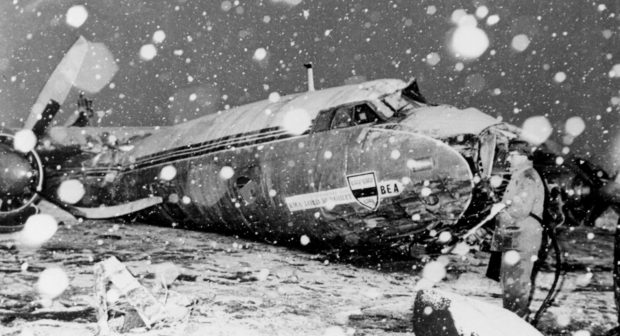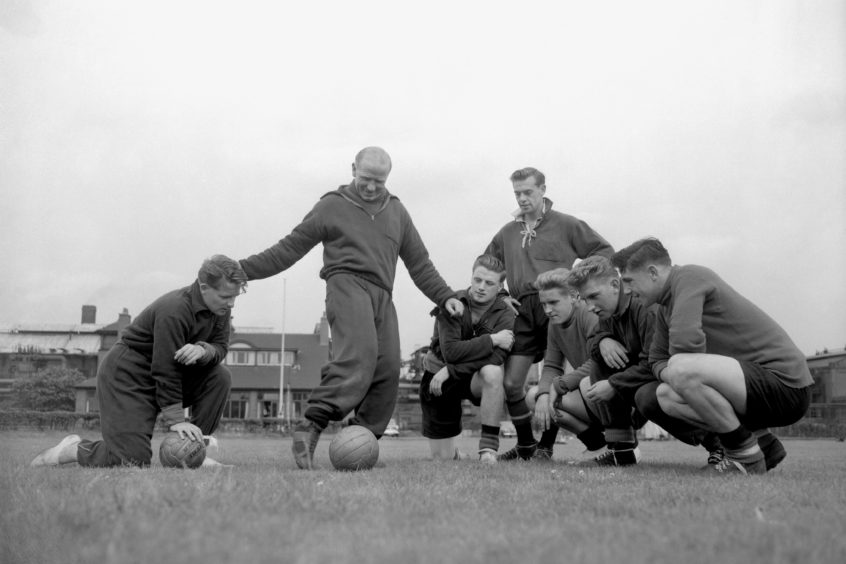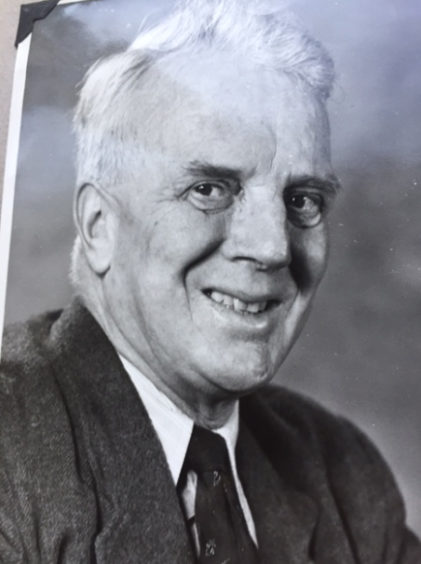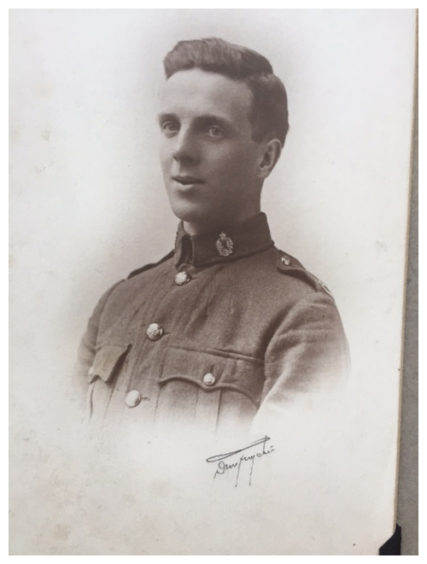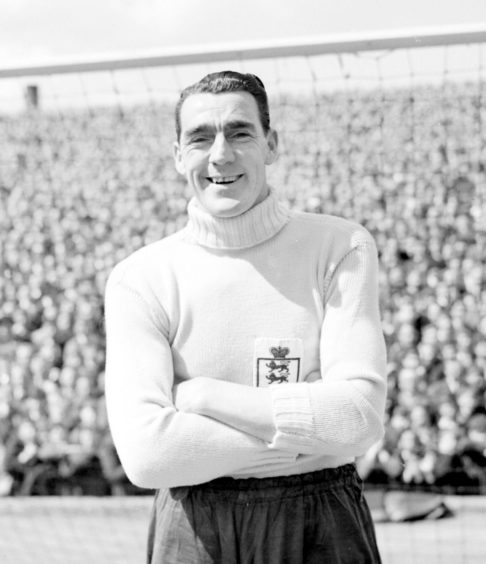It was one of the darkest moments in sporting history.
The plane crash on a snowbound afternoon in Munich eventually claimed the lives of 23 of the 44 people on European Airways Flight 609 and robbed the world of an emerging team of footballing greats.
Dundee journalist Charlie Caw didn’t take his place on the ill-fated Busby Babes flight on February 6 1958, but in a cruel twist of fate, just two days after the air disaster, he died of a heart attack back home in Giffnock in East Renfrewshire.
Solving the mystery
Mr Caw’s family are still hopeful they will find out just what happened on that fateful day as the Manchester United team headed back from Yugoslavia having secured their place in the European Cup semi-final following a 3-3 draw against Red Star Belgrade.
Mr Caw’s great-nephew Grant Millar from Angus said: “It spooks me a wee bit.
“It’s the ‘Sliding Doors’ aspect of the story that spooks me…how random life can be.
“The family remains just as curious and hopeful as before of trying to find out just what happened to Charlie on that fateful day.”
Journalist Charlie Caw was born in Dundee in 1894.
He was already a hero long before he started his journalism career having saved a boy from drowning at Broughty Ferry harbour in January 1911.
He worked for DC Thomson in Dundee and Glasgow before moving to The People newspaper where he covered football across Europe during a golden era for the game.
Caw Calling
Mr Caw also had a column in The People called ‘Caw Calling’ and was affectionately known as ‘Uncle Charlie’.
Mr Millar said Mr Caw should have travelled on the plane which was carrying the Manchester United team back from Munich in February 1958.
He suggested that a late change of plan might have meant that somebody took his place or that he changed planes.
He said: “Whatever happened had a massive effect on him and he died of a heart attack and hypertension 36-40 hours after the crash.”
Mr Caw would stay with family in London when he was flying abroad to cover European matches but the Munich story and how he missed his flight still remains a mystery.
He was only 63 when he died.
Of his two sisters, one lived to 88, and the other to 98.
His health may have been undermined by his war service.
He was evacuated from Gallipoli and sent to Ireland to be rehabilitated.
When he returned to Dundee his mother didn’t recognise him because he was thin, ill, lice-ridden and in a uniform faded from the sun.
She restored him to health before he was sent off to France.
Thin and ill
Mr Caw’s niece Jill said: “He was evacuated from Gallipoli, when they pulled out of there, and was sent to Ireland to be rehabilitated.
“I remember Mabel saying he arrived early one morning at the pub in Broughty Ferry and knocked on the door.
“Granny Caw opened the upstairs window and said: ‘Go away, go away’.
“There had been quite a lot of soldiers coming for food or money at that time, but it was too early for her to be feeling generous, which I know she was usually.
“Charlie said: ‘Oh Mama?’ and she realised who he was; thin, ill and in a uniform faded from the sun.
“Naturally, she raced down and welcomed him.
“However, having fed him up on good Irish food, and restored him to health, they then sent him off to France, and he had a long time there.”
He returned from the war and married his first wife, Elizabeth Annie ‘Isabella’ Mackenzie, who eventually died of tuberculosis, aged 26.
Tragic marriage
She was always very sickly and folk knew she would die young and he was strongly advised not to marry her but it was a grand passion and they were mad about one another, so they got married in Dundee in December 1921.
She died in November 1923 and her grave is in Barnhill Cemetery.
Mr Caw got married again to Sarah and they had a daughter called Sheila.
Mr Caw’s obituary when he died stated that he had been ill for some time although his family described this as misleading as he was working right up until his death.
The family still cling to hope that they can one day fill in the final chapter of his life story with the true story of what happened after the final whistle in Belgrade.
Remembering the Munich Air Disaster
The United squad and others on board set off for home following victory in Belgrade on a chartered British European Airways plane which stopped in Munich to refuel.
Engine issues led to two aborted take-off’s following refuelling.
Engines at full power
The pilots decided to make a third attempt and the passengers were re-embarked.
It never became airborne and ran off the end of the runway and across the 270-metre stopway with its engines at full power, broke through the boundary fence and collided with a house.
The aircraft and the house caught fire.
It skidded further and crashed into the concrete base of a wooden hut which caused the rear of the fuselage to break off.
The remainder of the wreckage slid on for 70 metres before coming to a standstill.
United players Geoff Bent, Roger Byrne, Eddie Colman, Mark Jones, David Pegg, Tommy Taylor, Liam “Billy” Whelan and Duncan Edwards died as well as secretary Walter Crickmer, chief coach Bert Whalley and trainer Tom Curry.
The journalists who died on the plane were Alf Clarke (Manchester Evening Chronicle), H D Davies (The Guardian), George Follows (Daily Herald), Tom Jackson (Manchester Evening News), Archie Ledbrooke (Daily Mirror), Henry Rose (Daily Express), Frank Swift (News of the World), and Eric Thompson (Daily Mail).
The young Manchester Evening News reporter chosen to replace Jackson, David Meek, returned to Old Trafford to write about a match 13 days after the crash.
He recalled: “It was a surreal atmosphere.
“The press box mood was weird as well.
“All the number one writers had gone and the replacements were all very young, very inexperienced, and very nervous.”
Some of the reporters who lost their lives were as revered by the Manchester public as were the players.
The funeral procession for Rose stretched six miles to the Southern Cemetery, with around a thousand taxi drivers ferrying mourners to the burial, without charge.
On this day in 1953, Busby Babe Duncan Edwards made his #MUFC debut at the age of just 16 making him United's youngest ever first team player at the time. Two years later he was making his debut for @England.
Sadly, Edwards died aged just 21 in the Munich air disaster in 1958😢 pic.twitter.com/OTNZJAmfau
— 3Retro Football (@3retro_) April 4, 2020
Among the lucky ones were Bobby Charlton and United manager Matt Busby, who survived, despite suffering severe injuries and being given the last rites.
Unluckiest Babe
Many of the eight players who lost their lives were household names but amongst them was a virtual unknown reserve left-back who could be considered the unluckiest of the Busby Babes.
Geoff Bent was a Salford lad, 25 at the time of Munich, but although he was one of the original batch of youngsters brought through by Busby, he’d only played for the first team 12 times in seven years.
He hadn’t played at all during the 1957-58 season and had just recovered from a broken foot.
But on the Saturday before United were due to fly to Belgrade, Roger Byrne was injured whilst playing against Arsenal and Bent was told he would be on the flight just in case he was needed to step in.
Bent was terrified of flying and apparently suffered nose bleeds even at modest altitudes.
In the event, Byrne recovered from his calf strain, played against Red Star and Bent wasn’t required.
Captain James Thain, who was the commander of the flight, battled for more than a decade to clear his name and never took the controls of a plane again.
Two German inquiries into the crash blamed him.
It was not until 1969 that the results of a British investigation revealed it was slush on the runway – the responsibility of the airport – rather than ice on the wings, which was the responsibility of the pilot, that caused the crash.
The British findings concluded: “Blame for the accident is not to be imputed to Captain Thain.”
Manchester United’s darkest day
Twenty-three of the 43 passengers on board the Elizabethan charter aircraft G-ALZU ‘Lord Burghley’ lost their lives in the Munich Air Disaster.
Roger Byrne, 28, full-back and club captain.
Mark Jones, 24, centre-half.
Duncan Edwards, 21, left-half. He died 15 days after the crash.
Tommy Taylor, 26, centre-forward.
Eddie Colman, 21, right-half.
Liam Whelan, 22, inside-right.
David Pegg, 22, outside-left.
Geoff Bent, 25, full-back.
Walter Crickmer, club secretary who was in charge of the side during the war.
Bert Whalley, chief coach, who was also responsible for youth development.
Tom Curry, who was regarded by Sir Matt Busby as “the best trainer in Britain”.
Alf Clarke, journalist, Manchester Evening Chronicle.
Don Davies, journalist, Manchester Guardian.
George Follows, journalist, Daily Herald.
Tom Jackson, journalist, Manchester Evening News.
Archie Ledbrooke, journalist, Daily Mirror.
Henry Rose, journalist, Daily Express.
Eric Thompson, journalist, Daily Mail.
Frank Swift, journalist, News of the World, who was also one of Manchester City’s greatest-ever players.
Captain Kenneth Rayment, co-pilot.
Bela Miklos, travel agent.
Willie Satinoff , supporter.
Tom Cable, steward
